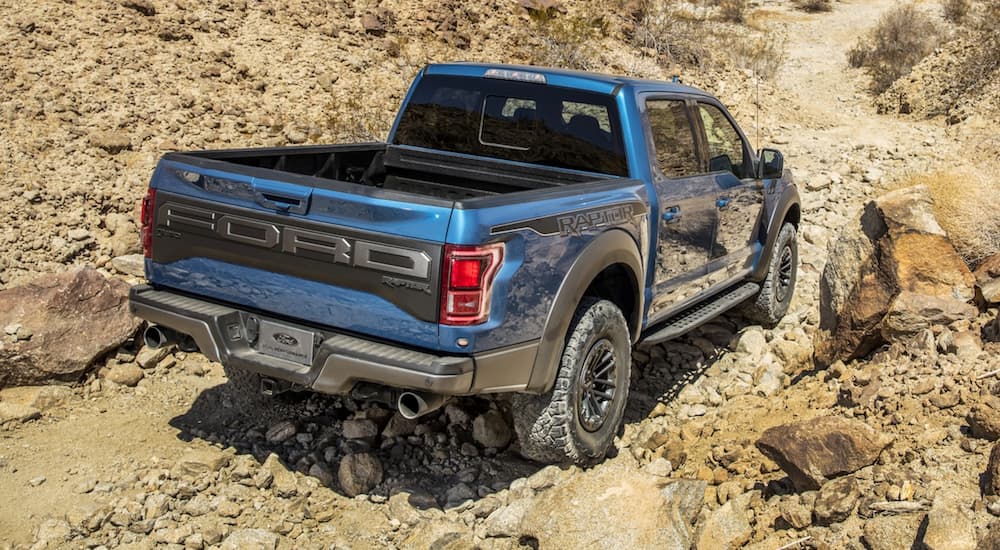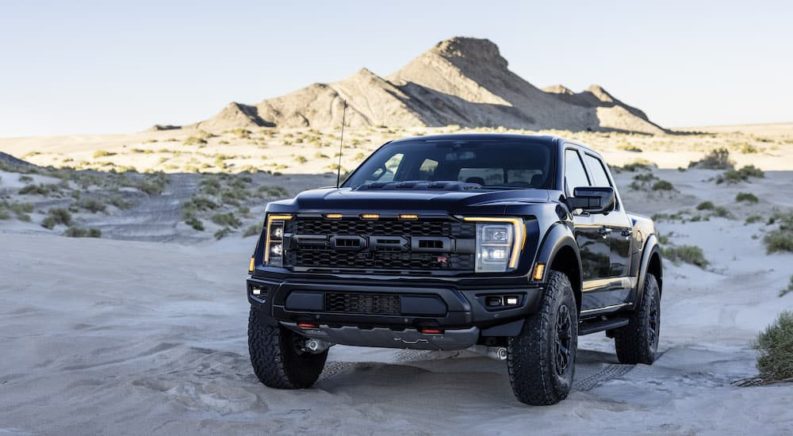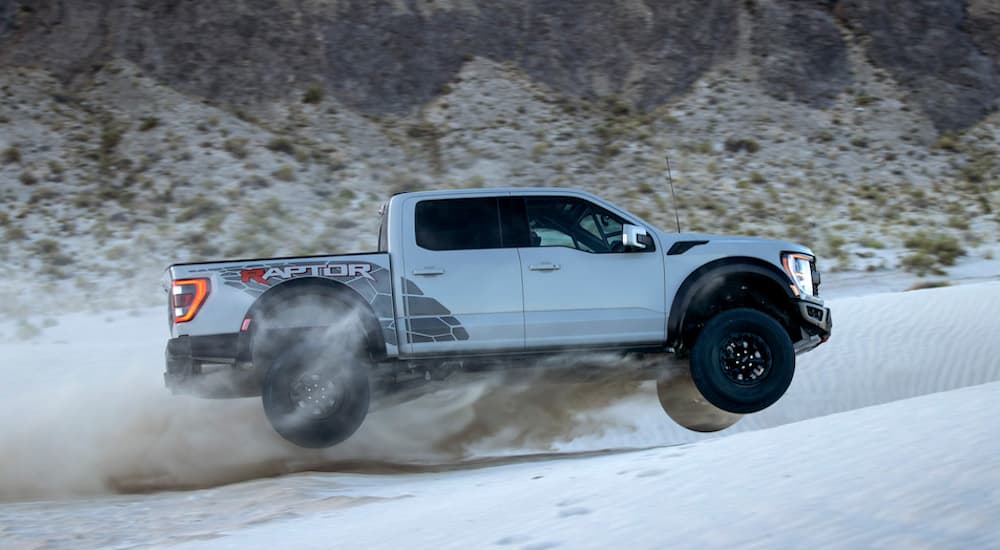The automotive industry is abuzz with news of the upcoming F-150 Raptor R that will arrive at Ford dealers for 2023. It’s the truck enthusiasts have been anxiously anticipating for several reasons. First, it’s Ford’s hard-hitting response to the Ram 1500 TRX, setting the stage for a Jurassic battle of epic proportions. After all, the T-Rex may have the height, but there’s no question that velociraptors have the agility and aggressiveness befitting of a true predator.
And speaking of a predator, that leads us to the second reason why the Raptor R has everyone up in arms. After years, it finally returns to its high-performance roots by exchanging its turbocharged V6 engine for a supercharged V8 codenamed “Predator.” It just seems fitting, doesn’t it?
The real question, however, is why Ford waited so long to make the change when it had the capability all along. Why let Ram beat it to the punch? As with any fierce predator, Ford was stalking its prey, studying its strengths, and uncovering its weaknesses before attacking. It turns out that patience is a virtue after all, and Ford certainly knows the value of waiting to gain the upper hand.
From V8 to V6: The Head-Scratching Swap
After the debut of the first-generation F-150 Raptor in 2010, Ford fans were thrilled with the off-road powerhouse destined to fulfill every need for speed and adventure. However, this excitement was soon overshadowed by the second-generation Raptor and Ford’s unthinkable move to replace the beefy 6.2L V8 with a smaller 3.5L EcoBoost V6 power plant. The swap left many scratching their heads in confusion, wondering when they would ever hear the roar of the beast again.
A First-Generation Powerhouse: 2010-2014
Ford introduced its Special Vehicle Team (SVT) at the 1992 Chicago Auto Show, tasking the group with designing exclusive, high-performance models. Throughout the 1990s and early 2000s, the team debuted the F-150 SVT Lightning, SVT Contour, and SVT Focus, each of which showcased Ford’s racing spirit and its penchant for speed. Then, after the debut of the SVT Focus in 2002, we heard nothing but crickets from the SVT team until 2010, when the first-generation F-150 SVT Raptor made its official debut.
The ultimate high-performance road warrior both on and off the pavement, the SVT Raptor embodied everything a speed demon and rugged adventurer was supposed to be. It rolled off the production line with an optional 6.2L V8 engine under its hood, delivering 411 hp and 434 lb-ft of torque. As a naturally aspirated V8, its rumble was immediately distinguishable, giving every enthusiast reason to pause in appreciation.
Besides power, the first-generation Raptor was also revolutionary because it took the F-150 platform to new heights, quite literally. The Raptor’s long-travel suspension with its Fox Shox Racing dampers at all four corners guaranteed its performance and gave it 11.2 inches of suspension travel in the front and 12.1 inches in the rear, a nearly 50% increase from the F-150 FX4. These improvements guaranteed the Raptor was ready for any and every adventure, earning it a place in SVT history as the most modified vehicle to wear the SVT badge.

Second-Generation Changes: 2017-2020
In 2014, Ford’s Special Vehicle Team merged with Ford Racing to form Ford Performance, a distinguishing fact that first-generation Raptor owners take great pride in because of the SVT Raptor’s limited production run and exclusivity. The second-generation Raptor, which debuted in 2017, was developed by the Ford Performance team and skipped the SVT badging of its predecessor for a cleaner aesthetic. However, these design modifications paled compared to what the Raptor housed under its hood.
The Ford Performance team replaced the naturally aspirated V8 from the first-generation Raptor with a high-output twin-turbo 3.5L EcoBoost V6 and a 10-speed automatic transmission with integrated paddle shifters on the steering wheel. Unfortunately, the change caused a deafening silence, eliminating the roar of the throaty V8 with an artificially enhanced grumble of the V6. It just wasn’t the same. So, why the swap?
As we know it today, Ford’s 3.5L EcoBoost accomplishes an incredible feat of balancing performance and efficiency. But is someone behind the wheel of a powerhouse like the Raptor really prioritizing fuel economy over performance? The EcoBoost is undeniably impressive, delivering 450 hp and 510 lb-ft of torque on the 2017 Raptor. It also added automatic stop-start technology, increasing the truck’s efficiency by powering off the engine when stopped and idling. But enthusiasts argue that the few pennies saved on fuel don’t make up for the roar of the V8 and the thrill of knowing the capability of what’s under the hood.
While the engine swap wasn’t met with open arms, the Raptor’s improved suspension modifications were a welcome addition in the off-roader realm. The second-generation Raptor offered even more suspension travel by upgrading the suspension components. This took the second-generation Raptor to 13 inches in the front and 13.9 inches in the rear. It also added nearly two inches of ground clearance to the truck, boosting its height to 11.5 inches to make it more capable on technical terrain.
Returning to Its V8 Roots
Ask any Ford enthusiast about the most iconic engines in Blue Oval history, and they’ll likely name the 5.0L Coyote. The Coyote was the first V8 engine to feature twin variable camshaft timing on the exhaust and intake, pushing the powerplant to deliver upwards of 460 hp by 2018 with the introduction of direct fuel injection. So, what does the Coyote have to do with the Raptor R? Absolutely everything.
In the wake of the second-generation Raptor, disgruntled drivers waxed nostalgic over the first-generation powerhouse. However, Ford was busy at work behind the scenes, even as Ram debuted the 1500 TRX as the fastest and most powerful mass-produced truck in the world. Ford’s “sit back and watch” approach left many questioning the automaker’s intentions until the recent announcement of the 2023 Raptor R with its supercharged 5.2L Predator V8 engine under its hood.
The Predator traces its roots to the 5.0L Coyote, which inspired the 5.2L flat-plane crankshaft V8 that made its way to the Shelby GT350. Known as the Voodoo, the engine cranked out 526 hp and 429 lb-ft of torque, but Ford knew it could do better. The response was outfitting the Mustang Shelby GT500 with the Predator, a supercharged 5.2L V8 that churns out 760 horses for jaw-dropping capability. Now, the Raptor R will enjoy that same power, directly positioning itself against the Ram 1500 TRX and its supercharged Hellcat V8.
Worth the Wait
The 2023 Raptor R sets the stage for fierce competition between two high-performance warriors. It also showcases Ford’s ingenuity in fine tuning the Coyote to meet the ongoing demand for more power from drivers, ultimately transforming its legendary V8 into the Predator. So, what does this mean for the segment?
Ford wasn’t resting on its laurels as Ram debuted the TRX, nor did it ignore the grumblings from Raptor fans after the V8 to V6 swap between the first and second generations. Instead, Ford engineers were quietly working on reinventing the warrior, adding an engine to easily beat the 702-horsepower Hellcat V8 under the hood of the TRX and make the Raptor the real apex predator of the class. Soon enough, Ford’s hard work will pay off, and the Raptor R will leave its rivals in the dust, leaving everyone to wonder, “What was the name of that Ram, again?”





